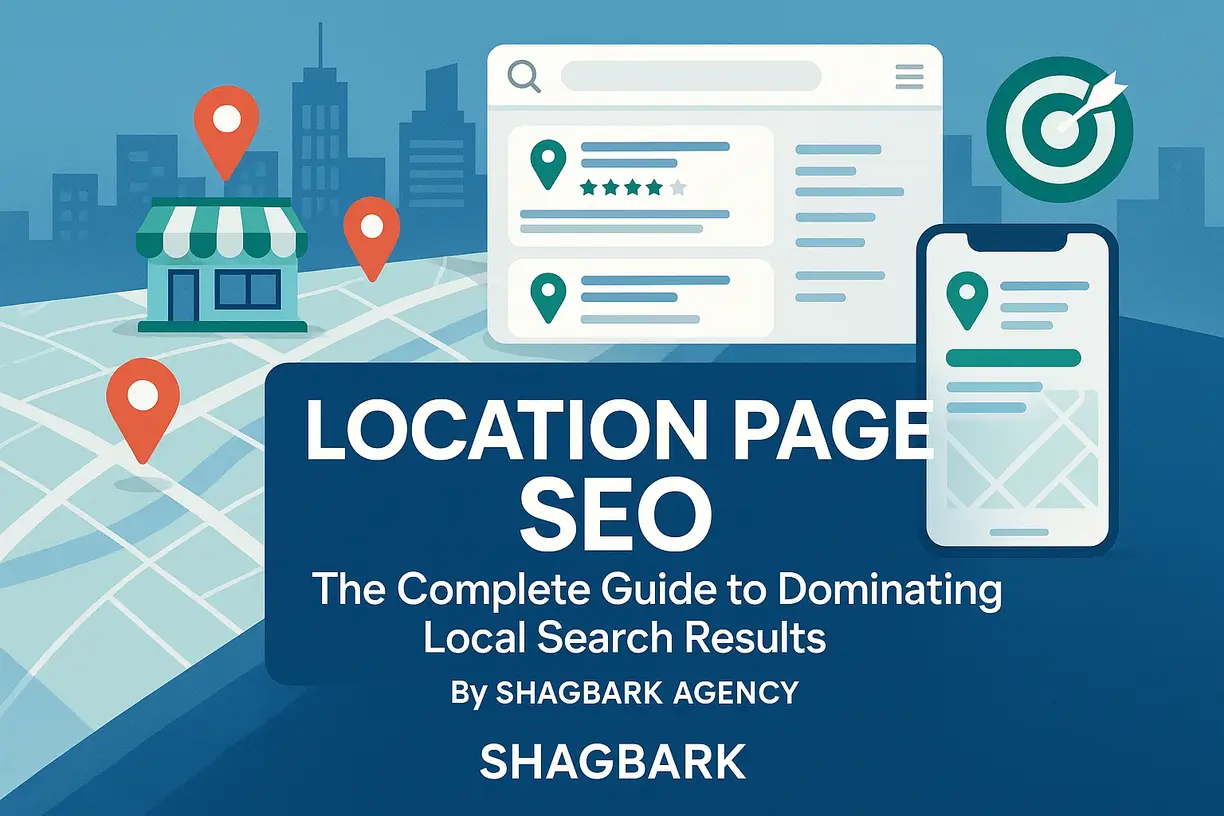
Local businesses face an undeniable reality: 97% of consumers search online to find local companies, and 46% of all Google searches have local intent. Yet most businesses struggle to capture this massive opportunity because they lack effective location page SEO strategies.
Location page SEO is the practice of optimizing individual web pages for specific geographic locations to increase visibility in local search results. When implemented correctly, location pages for SEO can dramatically boost your local rankings, drive targeted traffic, and convert searchers into customers.

Whether you operate a single location or manage multiple sites across different cities, mastering location page optimization is critical for sustainable local business growth. This comprehensive guide reveals the exact strategies and technical implementations that consistently deliver measurable results.
Key Takeaways
- Location page SEO directly impacts local business revenue by capturing high-intent searches with commercial potential
- Each location page must include unique, valuable content specific to that geographic market and target audience
- Technical implementation including proper URL structure, schema markup, and mobile optimization forms the foundation for success
- Multiple locations in one city require neighborhood-level optimization and clear service area differentiation
- Success measurement should combine traditional SEO metrics with location-specific indicators like local rankings and conversion tracking
- Advanced tactics like user-generated content integration and hyperlocal keyword targeting provide competitive advantages in crowded markets
Why Location Page SEO Is Critical for Local Business Growth
The statistics surrounding local search behavior paint a compelling picture for any business with physical locations or service areas. According to Google, 76% of people who search for something nearby on their smartphone visit a business within a day, and 28% of those searches result in a purchase.
Location page SEO directly impacts your bottom line by capturing high-intent local searches. When someone searches for “dentist near me” or “plumbing services in Chicago,” they’re often ready to make a decision quickly. Businesses that appear prominently in these results gain a significant competitive advantage.
The revenue impact extends beyond immediate conversions. Well-optimized location pages build long-term local authority, improve overall domain strength, and create a sustainable foundation for ongoing local marketing efforts. Studies show that businesses ranking in the top three local search results receive 44% more calls and 26% more direction requests than lower-ranking competitors.
Pro Tip: Expect to see measurable ranking improvements within 30-60 days of implementing comprehensive location page SEO, with full revenue impact typically realized within 90-120 days.
The Anatomy of High-Converting Location Pages
Successful location pages share specific structural elements that satisfy both search engines and users. Understanding these components provides the foundation for creating pages that rank well and convert visitors into customers.
Every high-performing location page must include consistent NAP (Name, Address, Phone) information prominently displayed above the fold. This information should match exactly across all online listings, directories, and citations. Even minor discrepancies like “Street” versus “St.” can confuse search engines and harm local rankings.
The page structure should follow a logical hierarchy with clear headings, concise paragraphs, and strategically placed conversion elements. Users arriving from local searches typically have immediate needs, so essential information like hours, services, and contact methods must be immediately accessible.
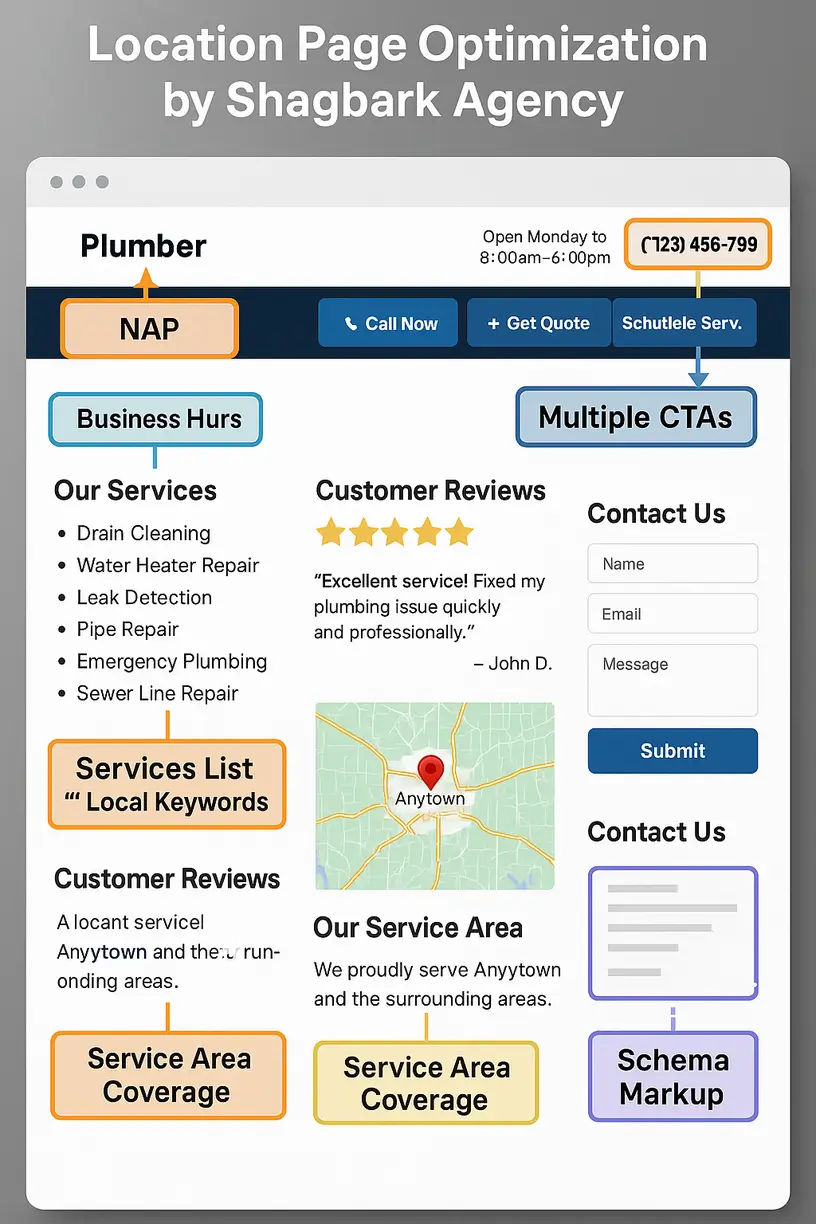
Content uniqueness remains crucial for location page success. Each page requires original, location-specific content that provides genuine value to local searchers. Generic content copied across multiple location pages will trigger duplicate content penalties and severely limit ranking potential.
Visual elements significantly impact user engagement and local SEO performance. High-quality, original photos of your actual location, team members, and work examples build credibility and improve time-on-page metrics that search engines consider when ranking pages.
Section Highlight: Mobile optimization is non-negotiable for location pages, as 60% of local searches occur on mobile devices. Ensure fast loading times, thumb-friendly navigation, and easily readable contact information on smaller screens.
Step-by-Step Location Page SEO Strategy
Developing an effective local SEO landing page strategy begins with comprehensive keyword research focused on your specific geographic markets. Start by identifying the primary service keywords your target customers use, then combine them with local modifiers relevant to your coverage areas.
Use tools like Google Keyword Planner, Ahrefs, or SEMrush to analyze local search volume and competition levels. Focus on keywords with commercial intent, such as “emergency plumber Atlanta” or “family dentist downtown Phoenix.” These terms indicate users ready to take action rather than simply browsing for information.
Map your keyword targets to specific location pages based on search volume, competition, and business priorities. Higher-value service areas should receive primary keyword targets, while secondary locations can focus on long-tail variations and niche service combinations.
Content planning requires balancing SEO optimization with genuine user value. Create detailed outlines for each location page that address common customer questions, highlight local connections, and showcase unique value propositions for that specific market.
The content calendar should prioritize locations based on revenue potential and competitive landscape. Launch high-priority location pages first, then systematically expand to additional markets while monitoring performance and refining your approach based on real data.
Pro Tip: Use Google Trends to identify seasonal keyword patterns in your local markets. HVAC businesses, for example, can optimize heating-related location pages before winter and cooling content before summer for maximum impact.
Technical SEO Implementation for Location Pages
Proper technical implementation forms the backbone of successful location page SEO. URL structure plays a fundamental role in helping search engines understand your page’s geographic relevance and topical focus.
Create clean, descriptive URLs that include both your target location and primary service keyword. For example, “yoursite.com/atlanta-emergency-plumbing” clearly signals geographic and topical relevance. Avoid complex parameters, session IDs, or generic page numbers that dilute SEO value.
Title tags must balance keyword optimization with compelling copy that encourages clicks from search results. Include your primary keyword and location within the first 60 characters, followed by your business name. “Emergency Plumber Atlanta | 24/7 Service | YourCompany” provides both SEO value and user clarity.
Meta descriptions, while not direct ranking factors, significantly impact click-through rates from search results. Craft compelling descriptions under 160 characters that include your target keywords, location, and a clear value proposition or call-to-action.
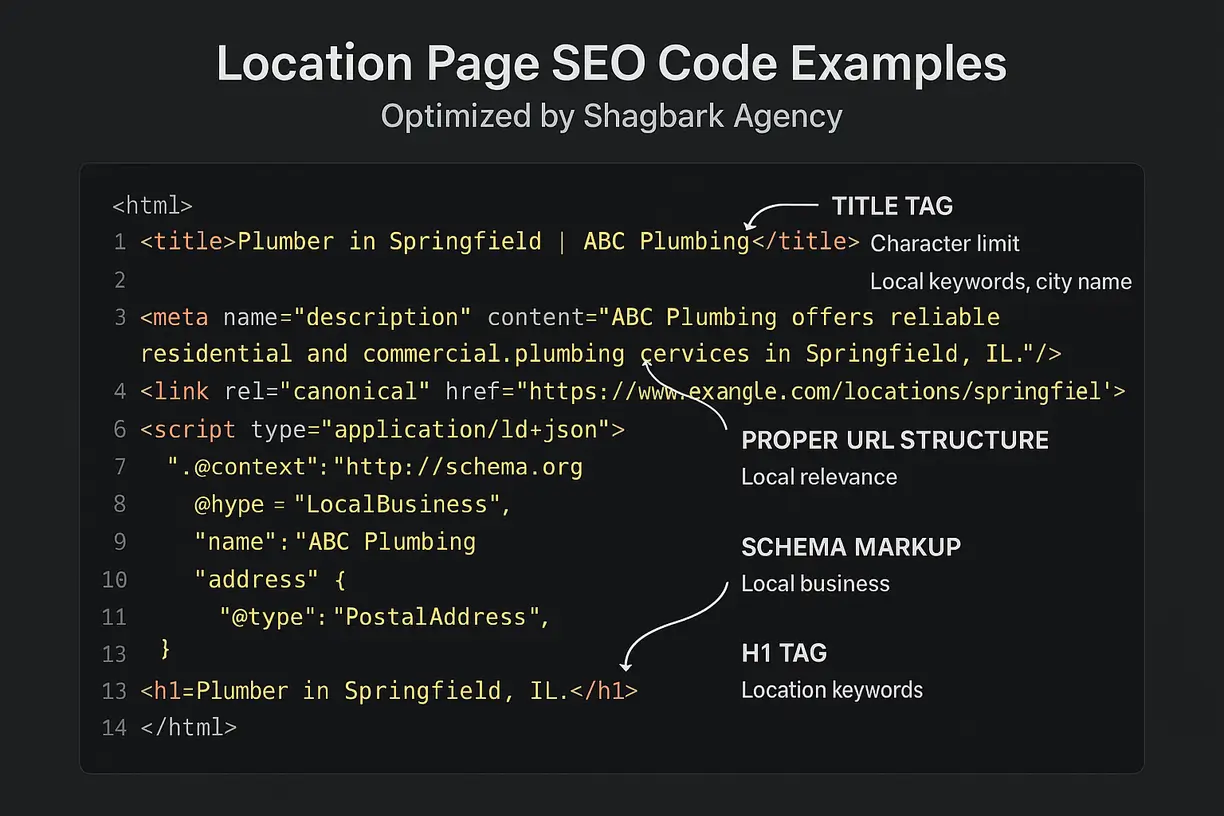
Schema markup implementation gives search engines structured data about your business locations. Use LocalBusiness schema to specify your NAP information, hours, services, and geographic coordinates. This markup enhances your chances of appearing in rich snippets and local knowledge panels.
Internal linking strategy should connect location pages to relevant service pages, your main contact page, and other related location pages. This structure helps search engines understand your site architecture while providing users with logical navigation paths.
Section Highlight: Avoid these common technical mistakes: duplicate title tags across location pages, missing or inconsistent schema markup, broken internal links, and mobile usability issues that increase bounce rates and harm rankings.
Creating Compelling Content for Multiple Locations
Content creation for location-based SEO requires balancing scalability with uniqueness. The key lies in developing templates that provide structure while allowing for meaningful customization based on local market characteristics and customer needs.
Start with a proven content framework that addresses universal customer concerns while incorporating location-specific elements. This might include sections on local service areas, community involvement, nearby landmarks, and region-specific customer testimonials or case studies.
Avoid the temptation to simply copy and paste content across location pages while changing only the city name. Search engines easily identify this practice and may penalize your entire site for duplicate content. Instead, focus on creating genuinely unique value for each location.
Local market research provides the foundation for authentic content differentiation. Study demographic data, local competitors, community events, and regional characteristics that influence customer behavior in each market you serve.
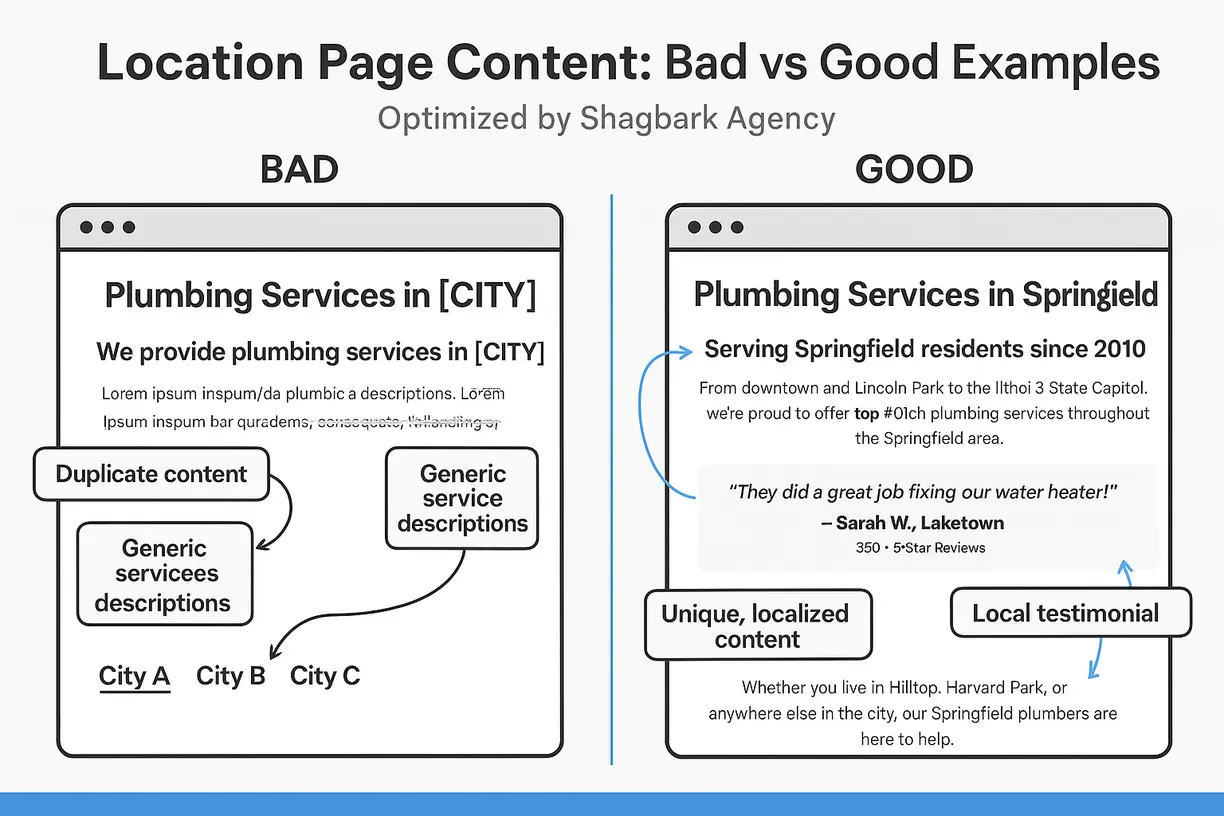
Incorporate local entities and landmarks naturally within your content. Mentioning nearby schools, shopping centers, highways, or notable businesses helps establish geographic relevance while providing useful context for potential customers.
Customer reviews and testimonials specific to each location add credibility and provide fresh, location-relevant content. Feature reviews that mention specific services, team members, or local details that reinforce your connection to each community.
Pro Tip: Create content templates with 60% standardized information (services, processes, company background) and 40% location-specific content (local details, community connections, area-specific needs) to efficiently scale while maintaining uniqueness.
Local SEO for Multiple Locations in One City
Managing local SEO for multiple locations in one city presents unique challenges and opportunities. This scenario commonly affects businesses like restaurants, medical practices, retail chains, and service companies with multiple offices or coverage areas within the same metropolitan area.
The primary challenge involves differentiating between locations that serve similar markets with comparable services. Search engines need clear signals about which location serves which specific areas, and customers need guidance about which location best meets their needs.
Neighborhood-level optimization becomes crucial in these situations. Instead of targeting broad city-wide keywords for every location, focus on specific neighborhoods, districts, or zip codes that each location primarily serves. This approach reduces internal competition while improving relevance for hyperlocal searches.
Service area differentiation helps clarify which locations serve which geographic regions. Create clear service area definitions for each location, potentially using zip codes, major roads, or neighborhood boundaries to establish distinct coverage zones.
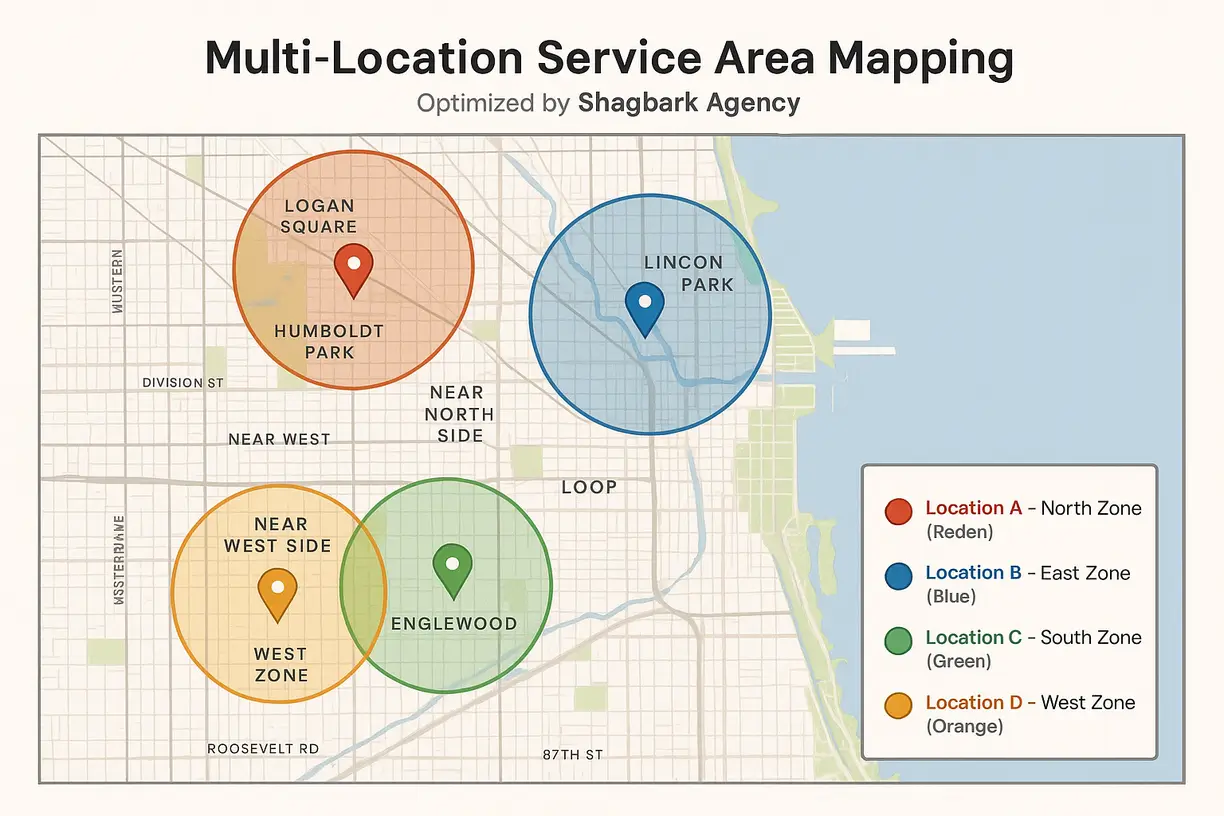
URL structure for same-city locations should include neighborhood or district identifiers rather than just the city name. Examples might include “yoursite.com/denver-downtown-location” and “yoursite.com/denver-highlands-location” rather than generic numbering systems.
Content strategy for same-city locations requires highlighting unique characteristics of each area. Focus on neighborhood-specific landmarks, demographics, local events, and community connections that distinguish each location from others in your network.
Section Highlight: Use Google My Business categories and service area settings strategically to help Google understand which location serves which specific neighborhoods, reducing confusion and improving local ranking potential.
Measuring Location Page SEO Success
Tracking location page performance requires monitoring both traditional SEO metrics and location-specific indicators that directly correlate with local business success. Establishing clear measurement frameworks helps identify successful strategies and optimize underperforming areas.
Local ranking tracking forms the foundation of location page SEO measurement. Monitor rankings for your target keywords across different locations, paying attention to both organic results and local pack appearances. Tools like BrightLocal, Whitespark, or LocalFalcon provide detailed local ranking data.
Organic traffic analysis should segment visitors by location and landing page to understand which location pages drive the most qualified traffic. Google Analytics 4 provides geographic reporting that reveals traffic patterns and user behavior across different markets.
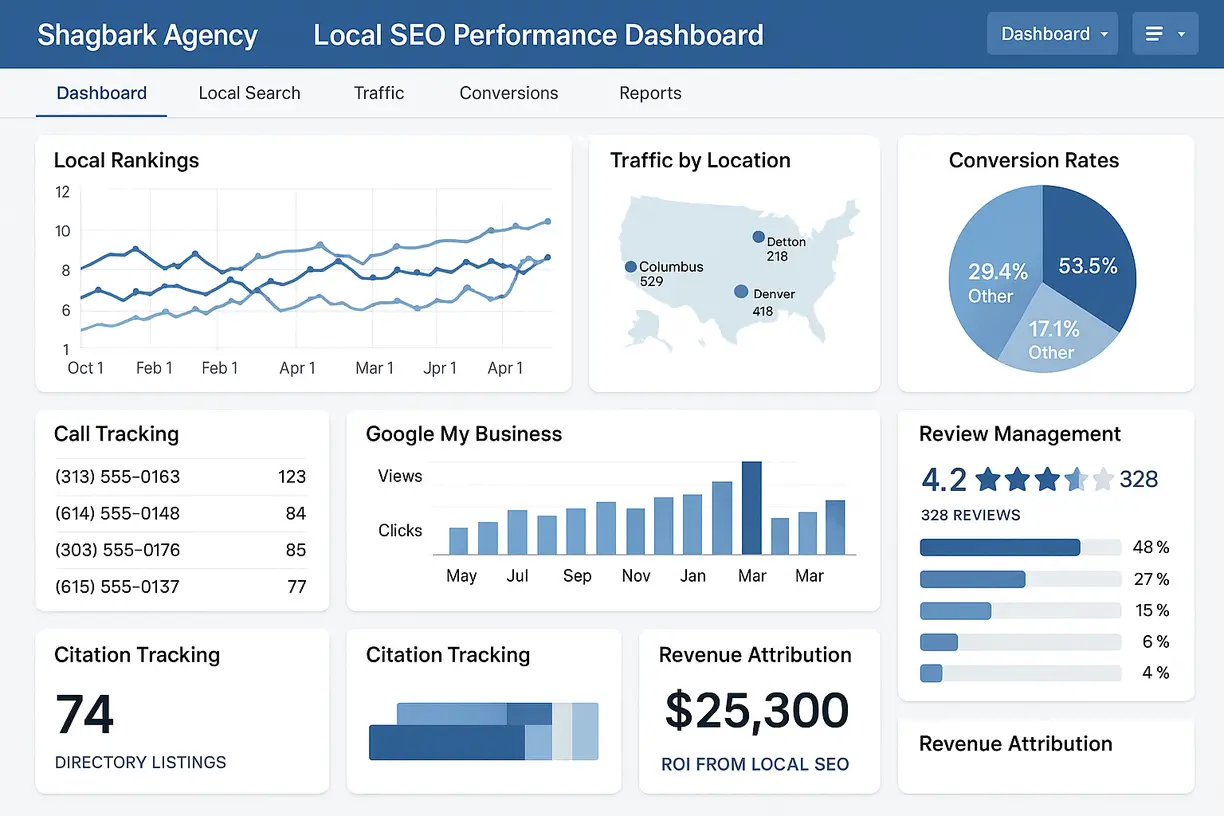
Conversion tracking becomes critical for measuring ROI from location page optimization efforts. Set up goals for phone calls, form submissions, direction requests, and appointment bookings to understand which pages and locations generate the most valuable actions.
Call tracking implementation provides insights into offline conversions generated by online location page visits. Use unique phone numbers for each location page to measure call volume and quality directly attributable to SEO efforts.
Review generation and management metrics indicate local reputation health across different locations. Monitor review velocity, average ratings, and response rates to identify locations needing additional reputation management focus.
Pro Tip: Create monthly location page performance reports that combine ranking improvements, traffic growth, conversion increases, and revenue attribution to demonstrate clear ROI from your location page SEO investments.
Advanced Location Page SEO Tactics
Advanced location page optimization techniques can provide competitive advantages in crowded local markets. These strategies require more sophisticated implementation but often deliver outsized results for businesses willing to invest in comprehensive local SEO approaches.
Location-based internal linking creates topical clusters that reinforce geographic relevance while improving overall site authority. Link related location pages together when geographically logical, and connect location pages to relevant service pages using location-aware anchor text.
User-generated content integration provides authentic, location-specific content that search engines value highly. Encourage customers to submit photos, reviews, and testimonials that mention specific locations, services, or local details.
Local event integration demonstrates ongoing community involvement while creating content opportunities. Document participation in local events, sponsorships, or community activities for each location to build local authority and provide fresh content.

Hyperlocal keyword targeting focuses on extremely specific geographic modifiers that larger competitors often overlook. Target specific neighborhoods, zip codes, or even major intersections where appropriate for your service area.
Competitor analysis at the location level reveals market-specific opportunities and threats. Analyze what local competitors do well for each of your target markets and identify content gaps or service differentiators you can exploit.
Schema markup enhancement beyond basic LocalBusiness markup can include service-specific schemas, review schemas, and event markup when applicable. Advanced schema implementation improves rich snippet opportunities and provides additional context to search engines.
Section Highlight: Implement progressive web app (PWA) features for location pages to improve mobile user experience, increase engagement metrics, and provide app-like functionality that encourages repeat visits and customer loyalty.
Conclusion
Location page SEO represents one of the most powerful strategies for local business growth in today’s digital marketplace. The businesses that master these techniques consistently outperform competitors, capture more qualified leads, and build sustainable competitive advantages in their local markets.
The key to success lies in balancing technical optimization with genuine user value, creating location pages that satisfy both search engine algorithms and customer needs. When properly implemented, location page SEO delivers measurable results that directly impact revenue and long-term business growth.
Remember that location page SEO is an ongoing process requiring consistent monitoring, optimization, and adaptation to changing search behaviors and competitive landscapes. The businesses that commit to continuous improvement and data-driven optimization consistently achieve the best long-term results.
Ready to dominate your local search results? The strategies outlined in this guide provide the foundation for location page SEO success, but implementation requires careful planning and ongoing optimization.
Get your free video SEO audit to discover specific opportunities for improving your location page performance and local search visibility.
Check Our Other Important Guides:
Google Business Profile Category Optimization Guide
How to Recover Local SEO Rankings
Google Business Profile Posts Best Practices
Frequently Asked Questions
Q: How many location pages should I create for my business?
A: Create one location page for each physical location or distinct service area where you can legitimately claim to serve customers. Avoid creating pages for areas where you have no genuine business presence.
Q: Can I use the same content across multiple location pages?
A: No, each location page requires unique content to avoid duplicate content penalties. Use templates for structure but customize content for each specific location and market.
Q: How long does it take to see results from location page SEO?
A: Most businesses see ranking improvements within 30-60 days, with significant traffic and conversion increases typically occurring within 90-120 days of comprehensive optimization.
Q: Should I create separate location pages for multiple locations in one city?
A: Yes, if each location serves distinct neighborhoods or areas. Focus on neighborhood-specific keywords and highlight unique characteristics of each location’s service area.
Q: What’s the difference between location pages and service area pages?
A: Location pages represent physical business locations, while service area pages target geographic areas you serve without a physical presence. Both serve important but different local SEO functions.
Q: How do I optimize location pages for mobile users?
A: Ensure fast loading times, prominent display of contact information, easy-to-tap phone numbers and directions buttons, and simple navigation optimized for touchscreen interaction.
Need Help with Local SEO Recovery?
If your local business has lost search rankings and needs expert recovery assistance, our team of Local SEO specialists is ready to help. Contact us for a free local SEO audit and recovery consultation.
Get Free Local SEO Audit